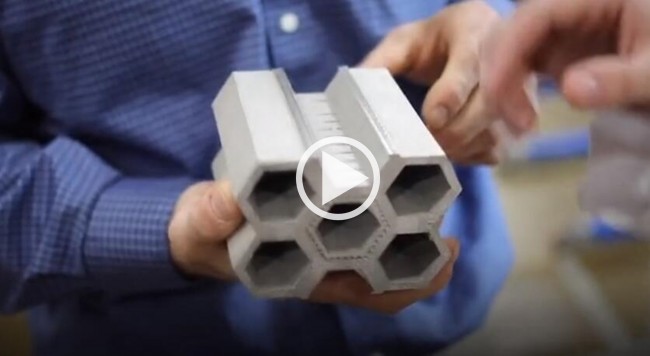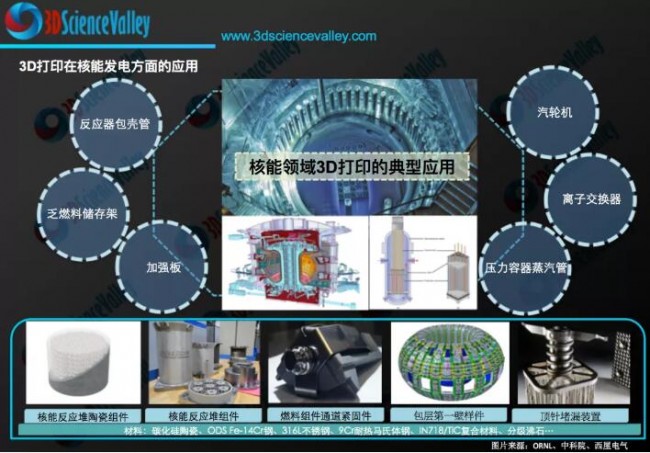Nuclear power generation is the fission of nuclear fuel made of uranium in the equipment of the “reactor” to generate a large amount of heat energy, and then use the water under high pressure to take out the heat energy, and generate steam in the steam generator. The steam drives the steam turbine to drive the generator. They spin together to generate electricity and are delivered to consumers through the grid. Nuclear power generation is an important pillar of the solution to reaching zero CO2 emissions globally by 2050, however, many existing nuclear reactors are likely to be decommissioned within the next 30 years as they are based on 70-year-old light water technology.
due to3D printingTechnology can achieve complex product shapes and make more special materials, research and develop different types3D printingThe application of technology in the field of nuclear energy has become increasingly important to the development of the next generation of nuclear energy. In this issue, join Guwang to learn how Oak Ridge National Laboratory uses 3D printing and artificial intelligence to improve nuclear reactor technology.
 © ORNL
© ORNL
If the engine is the “heart” of an aircraft, then a nuclear reactor can be called the “heart” of a nuclear power plant. Similar to the industrialization of 3D printing that has occurred in the aerospace industry, 3D printing is in the process of permanently changing nuclear energy technology in development. 3D printing and advanced manufacturing technologies may revolutionize the nuclear energy industry, driving a low-carbon transition of the energy system with small reactors. .
![]() Next Generation Nuclear Energy Equipment Manufacturing
Next Generation Nuclear Energy Equipment Manufacturing
Only one nuclear power plant has been built in the United States and Western Europe for 20 years, and countries have either phased out the technology entirely or commissioned projects that are experiencing rising costs. In addition, the shift from large-scale base electricity to intermittent renewables is raising questions about the relevance of nuclear power in the future.
An ongoing research project at Oak Ridge National Laboratory called the Transformation Challenge Reactor Program aims to change this gloomy fact. ORNL is working with materials, computational and manufacturing science, as well as 3D printing, artificial intelligence and big data to advance reactor core design.
 The application of 3D printing in nuclear power generation
The application of 3D printing in nuclear power generation
Oak Ridge National Laboratory’s Transformation Challenge Reactor program hopes to bring nuclear energy into the 21st century by deploying 3D printing and artificial intelligence to design and produce core reactor technologies. Technological advancements and the best new materials provide better, safer nuclear energy systems that can be deployed faster.
The most worrying of these is how the cost of nuclear power is soaring, with the UK’s Hinkley Point C nuclear power plant, for example, expected to cost £22bn.
To address cost concerns, Oak Ridge researchers are improving their design of 3D-printed gas pipes to the reactor core, using a planned 3D-printing method that can be printed using silicon carbide, a refractory material with High temperature and radiation resistance.
3D printing enables developers to achieve highly complex designs, such as those for cooling channels, using some high-performance materials, which were not possible before. New materials, such as silicon carbide, can also be used, which can significantly improve the performance and safety of the core.
![]() Digital Manufacturing and Artificial Intelligence
Digital Manufacturing and Artificial Intelligence
Additionally, 3D printing facilitates the construction of small volumes and “hybrid” structures. This means that researchers can embed and incorporate other components into the material, especially sensors. By integrating and embedding sensing and sensors into the structure, developers can extract more information from the system, such as equipment operation monitoring. This enables developers to get more data from the entire system, which is important for reducing operational costs as this creates a more reliable system with better monitoring information, which means more processes can be automated.
3D printing is digital manufacturing, which can also improve the qualification and quality assurance of the technology due to the ability to review how materials are made and whether they meet performance standards. Certification usually takes a long time and requires many processes. With 3D printing being done in small batches, researchers can gather information as they go, using sensing and other things to gather information on many different parameters, researchers are collecting “hundreds of gigabytes” of data sets that are similar to AI is used together to search for key performance parameters. This information is then used to determine whether the part meets the necessary quality standards after manufacture.
The researchers also plan to create a digital platform to help accelerate the adoption of additive manufacturing nuclear energy technology. Researchers are experimenting with an agile, iterative and dynamic approach for multidisciplinary projects. Instead of designing for months or years, it’s designing for days or weeks and then 3D printing it, unlike before. Then, from the prototype, developers can measure properties and performance parameters and feed them directly into the design.
ORNL is leading the Transformation Challenge Reactor (TCR) and is supported by a U.S. Department of Energy (DoE) program to explore faster and cheaper nuclear energy distribution in the United States to reduce manufacturing costs and lead times and improve safety. As part of the program, ORNL is building nuclear reactor cores using technologies such as direct energy deposition (DED) 3D printing. In 2020, Purdue University became a major contributor to the TCR program after receiving an $800,000 grant from the U.S. Department of Energy. As such, Purdue University is developing an artificial intelligence (AI) model to ensure nuclear-grade quality in 3D-printed components of the reactor core.
The TCR program also saw ORNL develop its own new 3D printing technology specifically for the production of nuclear reactor components. The process combines binder jetting and ceramic production processes to more efficiently manufacture components of complex shapes. The method can also print superalloys and refractory metals that are critical to the safe operation of nuclear reactor components due to their resistance to high temperatures and degradation.
Since the launch of the TCR program, ORNL’s 3D printed nuclear reactor components have been installed at the Browns Ferry Nuclear Power Plant in Alabama’s Tennessee Valley Authority (TVA). Four 3D-printed fuel assembly holders, developed in partnership with nuclear fuel supplier Framatome, are currently in regular operating conditions at the factory.
![]() Take advantage of structural integration
Take advantage of structural integration
Not only Oak Ridge National Laboratory, but also Westinghouse Electric took full advantage of 3D printing to achieve structural integration and developed a 3D printed isolation barrier for nuclear power fuel assemblies. The reactor core consists of a number of elongated fuel assemblies, each fuel assembly including a plurality of fuel rods containing fissile material that react to generate heat. The fuel rods of each fuel assembly are held in an organized, spaced array by a plurality of grids spaced axially along the length of the fuel assembly and attached to a plurality of elongated controls of the fuel assembly Rod guide sleeve.
By introducing additive manufacturing technology –3D printing technology, the Westinghouse-developed barrier can be printed without further assembly or soldering processes. The Westinghouse designed spacer grid has an axial dimension along the vertical axis of the elongated fuel assembly, and the nuclear fuel assembly grid includes a plurality of tubular fuel rod support units with four walls that are generally square in cross-section. In adjacent fuel rod support chambers or control rod support chambers, the interior of each wall supports vertical springs. Westinghouse also considered a mixing vane connected to the exterior of the fuel rod support units in the area between the fuel rod support units.
Compared to existing grid designs, the new design allows for smooth insertion of SiC-type fuel rods while also introducing a low pressure drop. Additive manufacturing technology enables spacer grid design to allow 1) the implementation of highly detailed yet fully integrated hybrid functions that enhance thermal and hydraulic performance; 2) minimize overall pressure drop; and 3) increase overall mesh strength to cope with vibration.
(responsible editor: admin)



0 Comments for “Using 3D printing and artificial intelligence to improve nuclear reactor technology”